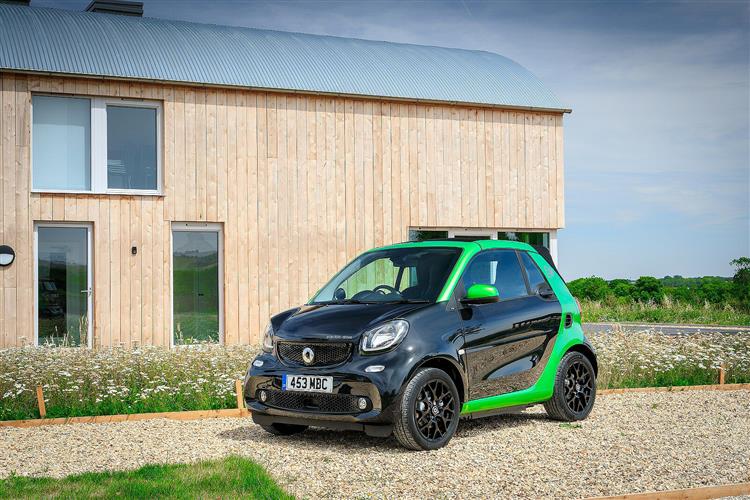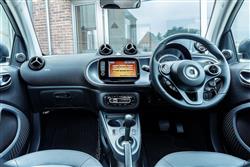CAB FOR THE CITY (some text hidden) --NONE--
By Jonathan Crouch
Introductionword count: 77
Smart's take on city centre motoring was at its cutest in open-top fortwo cabrio guise. This third generation version had wider appeal, classier, cleverer and more effective than ever in its town-targeted remit thanks to Mercedes engineering and shared development with Renault. As before, it was almost as nippy as a bike, yet as trendy as the priciest convertible. If you're urban-bound, here's a car with few really direct rivals and one it's hard not to like.
Modelsword count: 9
Models Covered : (2dr city car 1.0 petrol, EV])
Historyword count: 397
If the best thing about smart in this century's first two decades was the little fortwo, then arguably the best thing about the fortwo was this cute cabrio model. While its fixed-top stablemate sometimes struggled to justify its existence in a market filled with cheaper, more practical superminis, the cabrio version's appeal was perhaps easier to define. It was, quite simply, the least expensive open-topped car you could buy in this period. Here, we're looking at the third generation version. Before this model's introduction in 2016, we'd had open-roofed versions of this car since the year 2000; there was even a more extreme smart crossblade model in 2002 with no doors, no windscreen and no roof of any kind. Typical fortwo cabrio buyers though, like their creature comforts, hence the standardisation of a fully automatic soft top on all models following the launch of the second generation version in 2007. By this point, the cabrio body style was accounting for over 10% of fortwo sales, making this pricier variant a profitable car for the brand. This MK3 model was quite a different car to its predecessors. For a start, there were other influences in play with this design: some from Mercedes - as you would expect given the Daimler brand ownership - but others from quite a different quarter. Under the skin of this fortwo lay the underpinnings of a little Renault Twingo, which is why, for instance, customers could at last have a manual gearbox - as well as a much more sophisticated and far smoother automatic transmission option. Renault also helped the smart development team in improving some of the other things that put people off this car in the past, hence the changes made to increase cargo space and improve the previously unsettled quality of ride. This car's convertible appeal was enhanced as well - to the point where smart claimed it to be the only 'true' affordable cabriolet in its class. Neat removable roof bars enabled the creation of a completely open-to-the-elements feel that direct rivals like Fiat's 500C and the DS3 Cabrio just couldn't match. A sportier-looking Brabus version (with the 0.9 engine) arrived just after launch. The 'Electric Drive' EQ version was launched in 2017. Combustion-powered fortwo cabrio models were offered until 2019, after which an all-electric model (by now badged 'EQ') took over until the end of sales in 2023.
What You Getword count: 353
Would you like a fortwo cabrio? If you're urban-bound, it'd be hard not to be tempted by this MK3 model, providing the metropolis you have in mind isn't habitually smog-filled. Smart, we're told, is all about 'FUN.ctional' design and with that in mind, it helps that this feels like a proper convertible in a way that comparably-priced rivals from this period simply don't. The roof bars that you have to have permanently attached on comparably-priced rival models can, on a fortwo cabrio, be easily unclipped and then stored in this little compartment on the inside of the tailgate. From inside the car, the mechanism works by pressing a switch near the gear lever. Opening or closing can be done at any speed and the full process occupies just 12 seconds. You may not want complete activation or retraction though, given the appeal of a provided interim 'sunroof'-style setting. Out back, the twin-section tailgate was carried over from the previous model, complete with its user-friendly upper opening glass section. With everything open, you get an amazingly tardis-like cargo bay, boot space to the window line rated at 260-litres, the same as you'd get in the fixed-top model and 20-litres more than the previous generation model could offer. At the wheel, the spacial surprises continue and you'll quickly find yourself wondering how on earth something so diminutively small outside can feel so large and airy within. Unlike previous fortwos, you feel that you're in a proper car, rather than some kind of cramped urban mobility pod. The dashboard's a two-piece affair, with the upper part trimmed in a lovely mesh-effect fabric coating that looks great, though we wouldn't want to have to try and get melted chocolate out of it. This can be colour-co-ordinated alongside the central seat facings and the middle panels in the doors, with black, blue or orange themes. Further funky touches include the four spherical air vents with their friendly clickety mechanisms. And an unusually-configured air conditioning unit, on which the desired temperature can be set on a central scale you select from with the aid of a sliding magnifying glass.
To see the full road test text contact us on 0330 0020 227
Pictures (high res disabled)

.jpg)
|
.jpg)
|
.jpg)
| |||
.jpg)
|
.jpg)
|
.jpg)
| |||
.jpg)
|
.jpg)
|
.jpg)
| |||
.jpg)
|
.jpg)
|
.jpg)
| |||

|
Scoring (subset of scores)
Category: Convertibles
| Performance | |
| Handling | |
| Comfort | |
| Space | |
| Styling, Build, Value, Equipment, Depreciation, Handling, Insurance and Total scores are available with our full data feed. | |



